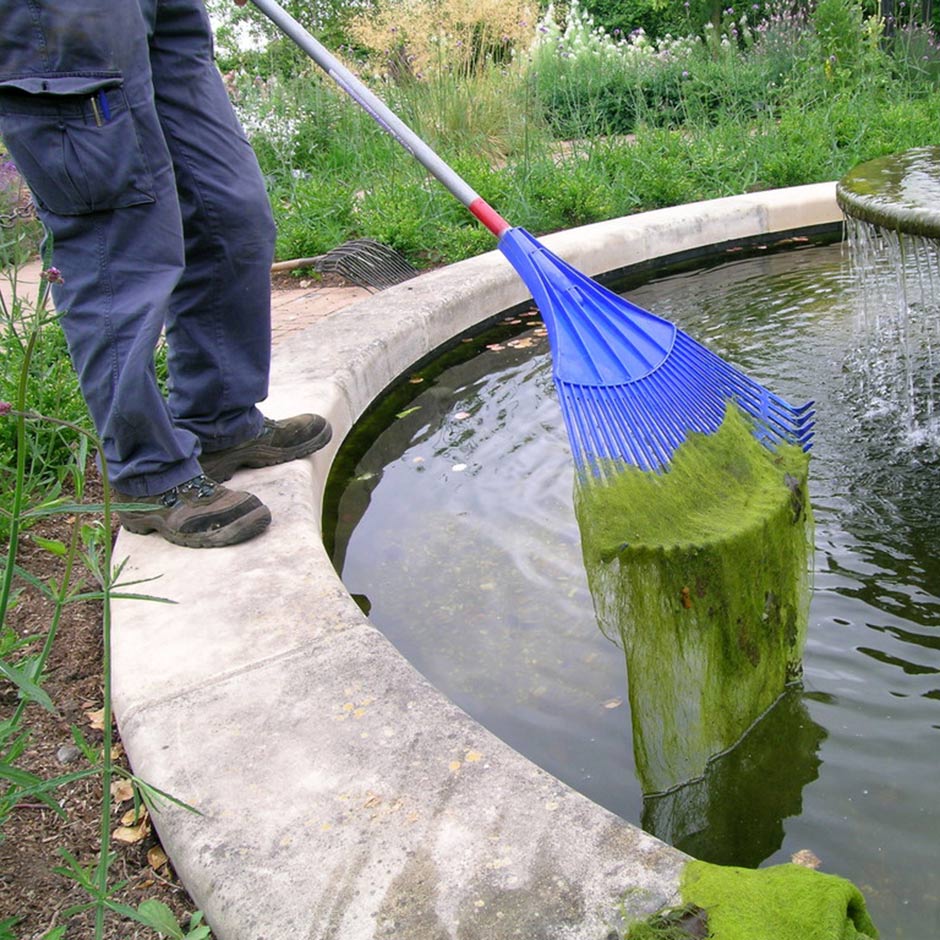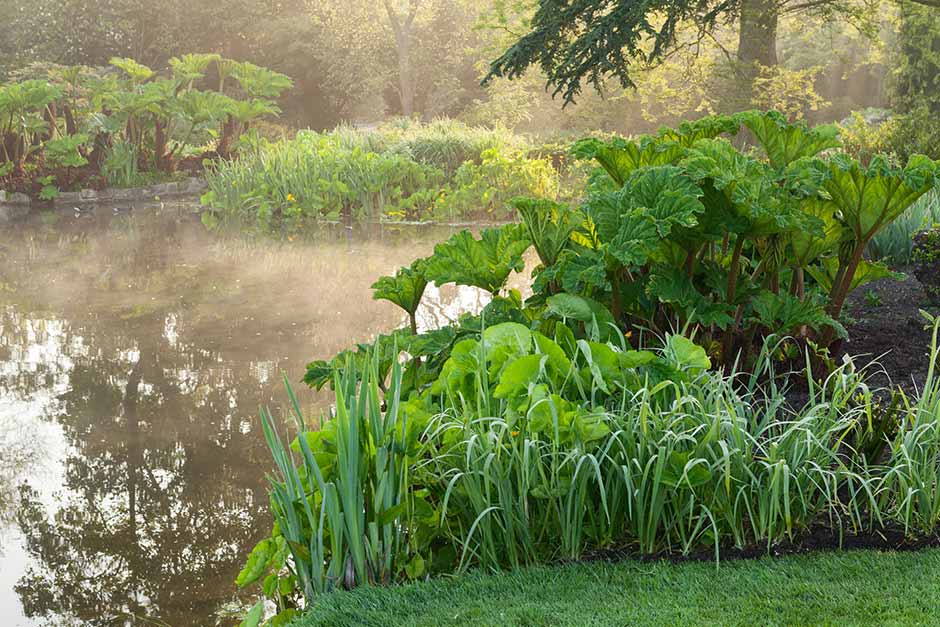Pond care
A pond is an asset in any garden – both an attractive centre piece and a magnet for wildlife. And just like any area of the garden, occasional maintenance will help to keep it in good condition and looking great.

Quick facts
- Remove dead, tatty or fading leaves, so they don’t decompose in the water
- Cut back vigorous plant growth – aim to keep half the surface clear
- Ensure the water is well oxygenated
- Consider cleaning out, if very overgrown and/or silted up
Jump to
How much maintenance?
But just beware of too much intervention – it can upset the pond’s natural balance and deter wildlife. Ponds rarely need a complete clear-out, unless they’ve become extremely overgrown or silted up.
Our tips below will help you tackle the right jobs at the best times of year.
Looking after pond plants
Plants add valuable habitats for wildlife and enhance the beauty of a pond – keep them looking their best with these simple steps.
In spring:
-
Add new plants, if you wish, from mid-spring to early summer, when the water is warming up – they should settle in well and grow rapidly. See our guide to planting aquatics and our planting wildlife ponds video
-
Divide and re-pot deep-water aquatics with floating leaves, such as waterlilies, if they’ve become too large – see our guide to growing waterlilies
-
If plants such as waterlilies flowered poorly the previous year, consider feeding with a specialist aquatic plant food, but avoid feeding if not required
In summer:
-
Cut back excess plant growth if necessary – aim to keep about 50 per cent of the surface free of vegetation
-
Snip off any tatty leaves within reach, and fading flowers too, so they don’t decompose in the pond
-
Thin out excessive growth of underwater oxygenating plants – four to five bunches (each containing three to four stems) should be sufficient for each square metre/yard of pond surface
In autumn:
- Remove fading leaves and stems of plants in and around the pond as they die back, to avoid decomposing vegetation building up in the pond
Also see our pond plant guides:
Choosing pond plants

How to grow aquatic and bog plants
Pond plant propagation
Summer pond care
-
Top up ponds with fish if the water level drops significantly. Evaporation in hot or windy weather can reduce oxygenation, causing problems for fish. Ideally use rainwater from a butt, as the nutrients in tap water encourage algae. If you must use mains water, warm it in the sun first and add in small quantities, to avoid a sudden temperature drop. Topping up isn’t usually necessary if there are no fish – most wildlife will cope with fluctuating water levels. If the pond liner becomes visible, consider adding a stone-covered liner or allowing pond-side plants to grow over the edge, to help disguise the exposed liner and protect it from sunlight
-
Keep the water well oxygenated in hot, humid weather, especially if you have fish, by running a bubble fountain or similar. Solar-powered fountains are readily available. This can also help to deter blue-green algae
-
Check any wildlife ramps to make sure they’re still in place. These are particularly important in ponds with steep sides, so wildlife can get in and out safely. See our guide to wildlife ponds
-
Remove floating weeds and pond algae if necessary, as growth can be rapid in warm weather. Twirl them out with a stick or scoop out with a net. Leave them on the side of the pond overnight, so larger creatures can return to the water. Rinsing the material in a bucket of pond water can help release smaller creatures, which can then be returned to the pond. See our guides for more tips:
Aquatic weeds
Pond algae and blanket weed
Winter pond care
Look after your pond and its wildlife over winter with the following tips:
-
If your pond freeze over, take action if it contains fish, as oxygen levels can drop. Melt some of the ice by placing a hot pan on the surface, or consider a bubble fountain or pump to add movement and raise oxygen levels. Floating a ball on a pond in cold weather can also delay freezing (but make sure it doesn’t risk attracting children onto the ice). Never smash the ice, as the shock waves can harm fish. Keeping some of the pond ice-free also gives wildlife access to fresh drinking water
-
Circulating the water with a pump helps to improve oxygen levels, which benefits both amphibians and fish, particularly in deeper ponds where oxygen doesn’t diffuse readily through the water
-
Ensure plenty of light reaches the pond by pruning back overhanging branches and brushing off any snow. This will allow submerged plants and algae to continue to photosynthesise and replenish oxygen levels in the water. Consider adding more oxygenating plants in spring if you don’t have many
-
Check the water level – if it drops in winter, it may indicate there’s a leak. Butyl rubber liners and fibreglass moulds can often be repaired – kits are available from specialist suppliers
Cleaning out a congested pond
First, consider whether a total clean-out is really necessary. The traditional advice is to give small ponds a complete overhaul to remove debris every five years, and give large ponds a thorough clean every ten years.
However, cleaning out a pond can seriously disrupt its natural ecosystem, which can take several years to recover. It can also be physically demanding and messy work, especially with a large pond. And you need a lot of collected rainwater to refill the pond afterwards. For tips on maintaining a healthy pond ecosystem, see our guide to wildlife ponds.
But if your pond is crying out for an overhaul, perhaps because it has silted up or become too overgrown, then the best time to do it is in early autumn, when many creatures are less active.
These are the key steps:
-
Start by preparing a holding tank (or large buckets) in a shady spot for fish and deep-water plants. Use some pond water in the tank, unless it’s particularly cloudy. Marginal (water’s edge) plants will survive out of the pond temporarily, as long as they’re kept moist and shaded
-
The easiest way to drain the pond is to use a pump, which can be rented for the day from a machinery hire shop
-
As the water level falls, remove any fish as they become visible, carefully placing them in the holding tank. Do likewise with any larger pond creatures you find
-
Remove the plants gradually too, as the water level drops. Take the opportunity to re-pot or divide them if necessary – see our guide to propagating pond plants
-
Place decaying plant material on the side of the pond, so any smaller creatures hiding in it can return to the pond later
-
Scoop out the silt from the base. You can add this to your borders, but retain a little to put back into the pond as it will help re-establish tiny aquatic organisms
-
Clean the liner with a scrubbing brush and fresh water, bailing out the dirty water with a bucket
-
Return the saved silt and any saved pond water. Next, refill with pond (using rainwater if possible), positioning the pond plants as you go – see our guide to planting aquatics
-
Finish by returning the fish and any other pond wildlife
Get involved
The Royal Horticultural Society is the UK’s leading gardening charity. We aim to enrich everyone’s life through plants, and make the UK a greener and more beautiful place.